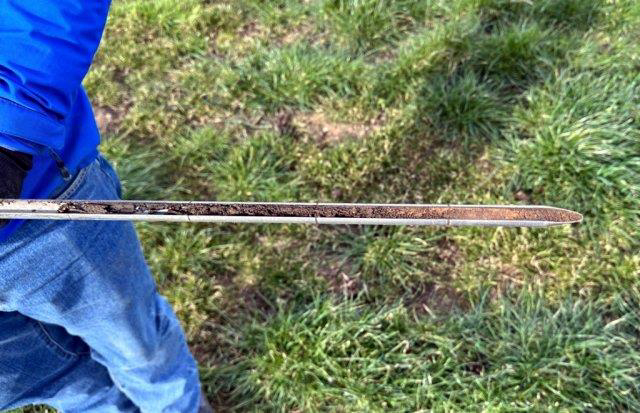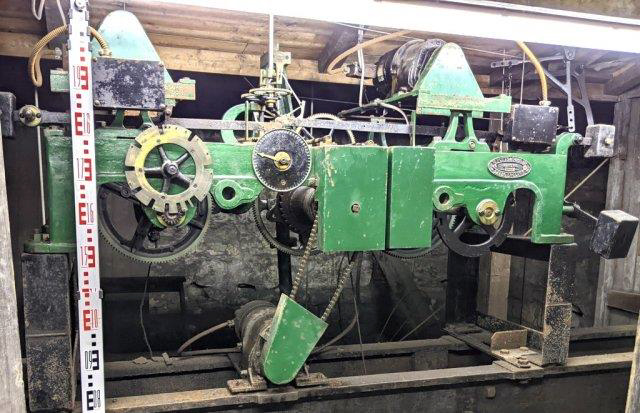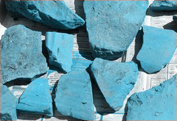
With the weather improving all the time, we're now thinking about venturing into the field once again. In fact Patrick and Chris have already been on site to inspect the trenches we left open last year. Apart from a partial collapse in Trench 1 and 6 being full of water, the rest are dry and in relatively good condition. Chris also wanted to try out a corer he has borrowed to see if it can detect where the ditch is and where it isn't.
The technique involves taking 25cm x 15mm diameter cores down to a depth of about a meter. By examining the colour of the samples, the nature of the subsoil can be seen and thus the presence of the ditch detected. On the day they took cores from locations around Trenches 5a and 7 where the ditch is known to be. The results we very favourable showing that this technique will be very useful in discovering if there are any more gaps around the circuit.
At the end of last year's digging season, we got the result back from the charcoal sample taken from the bottom of Trench 1 which gave a mid Bronze Age date (i.e. 1501 (95.4%) 1425calBC). Although gratifying to confirm our site is prehistoric, we were surprised with this date. Typology was suggesting the site was a henge rather than a barrow and therefore an earlier date had been expected. Towards the end of the year two more samples were sent off for testing. This time they had been retrieved from the burnt wood feature at the bottom of Trench 5. One sample went to the Chrono14 labs at Queens University Belfast, the second to CARD which a free service specifically set up for amature groups. We have now had the results back from the former - this time the calibrated date given is between 1600 and 1700 BC. Although 100 to 200 years earlier, it's still in the mid Bronze Age range.
Last week we also had a planning meeting to discuss our targets and strategy for this season's work. Although investigation into the ditch circuit will continue, our focus this year will be on the central mound area. Ideally the whole area would be strip of its topsoil and quarter sections excavated. However, with the limited resources at our disposal, we will have to be more focussed on any target areas we can identify. Our resistivity survey has revealed a couple of potential targets and a group from the Wirral have offered to do a magnetometer survey for us which will hopefully throw up more targets. To start with though, our first task will be to extend one of our existing trenches towards the centre of the mound. This will enable us to get a better idea of its construction. Work will start later this month - as usual if you want to get involved let me know (if it's only to do some sieving of the spoil heap).
Church Tower Project
We are coming to the end of this survey, with only one or two more visits to see it through. Our recent visits have concentrated on the upper levels, i.e., the clock mechanism room and belfry. Although the structure of the tower in this area dates from the medieval period, the current arrangement comes from the mid 19th century when the tower was extended. The original position of the clock was in the belfry just above the bells (the clock faces can be seen on old sketches mounted just above the belfry windows). When the new set of bells were installed, the clock was relocated into its own room positioned below the belfry. A long drive shaft travels from the mechanism, through the bells in the belfry, up to a bevel gear distribution block to drive the hands on all four clock faces in the extended tower.

The story of the current clock is interesting - a plaque on it suggests it was only installed in 1968 by W Potts Ltd of Leeds, but its appearance suggest it to be much older. Research reveals that in fact it dates from 1897 when it was installed in St Andrew's Church, Bradford. When that church was demolished in 1967, the movement was taken back to the works in Leeds for reconditioning and electrification. It was then installed into the tower replacing the original one there.
Next Meeting
Wednesday 5th April - at the Real Crafty on Upper Dicconson Street starting at 7.30pm as usual. Now that the Parish Church Tower project is reaching its conclusion, we thought it a good time to present its results i.e. information gathered and progress made. Peter Layland, who instigated the project, has therefore agreed to do this. He will also present his research into the origins of the church and its development into what we see today. This has been a fascinating journey of discovery which I'm sure you will all enjoy. Hope to see you there - BA.
|



